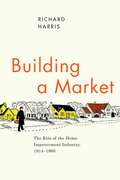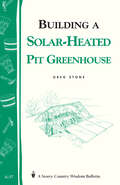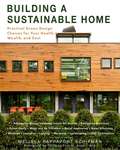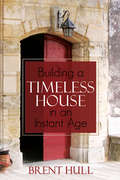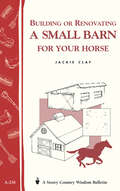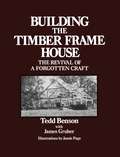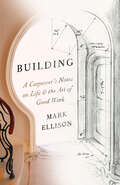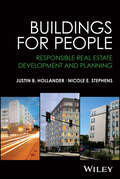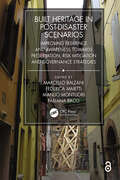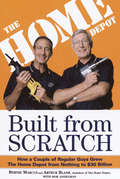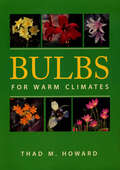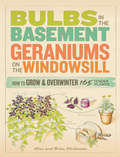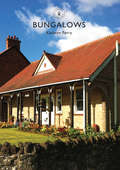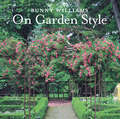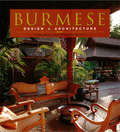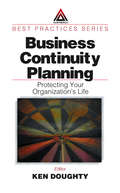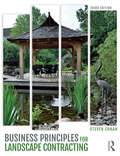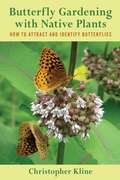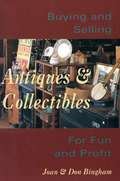- Table View
- List View
Building a Market: The Rise of the Home Improvement Industry, 1914-1960
by Richard HarrisEach year, North Americans spend as much money fixing up their homes as they do buying new ones. This obsession with improving our dwellings has given rise to a multibillion-dollar industry that includes countless books, consumer magazines, a cable television network, and thousands of home improvement stores. Building a Market charts the rise of the home improvement industry in the United States and Canada from the end of World War I into the late 1950s. Drawing on the insights of business, social, and urban historians, and making use of a wide range of documentary sources, Richard Harris shows how the middle-class preference for home ownership first emerged in the 1920s--and how manufacturers, retailers, and the federal government combined to establish the massive home improvement market and a pervasive culture of Do-It-Yourself. Deeply insightful, Building a Market is the carefully crafted history of the emergence and evolution of a home improvement revolution that changed not just American culture but the American landscape as well.
Building a Solar-Heated Pit Greenhouse: Storey's Country Wisdom Bulletin A-37 (Storey Country Wisdom Bulletin Ser.)
by Greg StoneA solar-heated pit greenhouse combines the energy-conserving features of the traditional pit greenhouse with newer techniques and materials used in standard heated greenhouses. The result is a simple, inexpensive structure that blends into its environment and needs little or no heat from any source other than the sun. Greg Stone’s simple, illustrated, step-by-step instructions show you exactly how to design, site, and build your own solar-heated pit greenhouse from start to finish.
Building a Sustainable Home: Practical Green Design Choices for Your Health, Wealth, and Soul
by Schifman MelissaThe green building movement has produced hundreds of “how-to” books and websites that are filled with tips about green building and what homeowners should do to go green. While helpful and informative, when it comes to making actual purchasing and installation decisions, these books do not make it any easier for a homeowner to prioritize against a budget. The Sustainable Home serves this need, as it is written by a sustainability advisor and financial advisor who has personally directed the building and LEED certification of her own home. Here, she shares her knowledge and experience for others to use in their journey toward a greener way of living. Whether the reader is building a new home or doing a minor remodel, a homeowner needs a framework by which to guide their decisions. These decisions are based on values, and the author posits that there are really only three reasons to go green: For Our Health: By building more sustainably, we reduce our exposure to harmful chemicals and toxins. For Our Wealth: By building a more durable home and being more efficient with resources like water and electricity, we reduce our monthly utility bills and ongoing maintenance expenses. For Our Soul: Collectively doing the right thing for our planet does make a difference—and that is soul-nourishing. Learn the logistics of choosing windows, insulation, appliances, and lighting. Find out about FSC certified wood and about using reclaimed materials. Here is everything you need to make your home sustainable.
Building a Timeless House in an Instant Age
by Brent HullThe author of Traditional American Rooms examines the evolution of home construction, making a case against mass-produced homes.HISTORY®’s Lone Star Restoration star, Brent Hull is a master craftsman, and hands-on preservationist. Hull—a Foreword Reviews Book of the Year Finalist for architectural non-fiction—challenges us to consider the impact our decisions will have when building a house. What do our homes say about us? What stories are they telling? Are they declarations of integrity, beauty, and heritage? Or do they suggest we have lost our sense of value, craft, and harmony?Nationally recognized as an authority on historic design, architecturally correct moldings, and millwork, Hull is uniquely qualified to speak to the craft of building and art of design. In an age of “instant”‘ homes, how do we build something timeless that weaves a tale of character, values, history, and heart? The decisions we make for our homes are not inconsequential. What we build defines us. In fact, the contrast between the way we build today and how structures used to be built has become only more vivid. What happened to craft? What happened to the art of building? Our values and what we believe about life have changed as well. We have come to see houses as a tradable commodity. We live in a time that is obsessed with “what’s next?” We need to be careful of fooling ourselves into thinking that a bottom-line mentality is the best way to approach building a home. Now is the time to examine ourselves, our motives, and our hearts.Praise for Building a Timeless House in an Instant Age“Part call to action, part exploration of technique, the result is a persuasive and enjoyable reminder that our homes are reflections of ourselves . . . . A pleasing, educational look at traditional home construction.” —Kirkus Reviews
Building or Renovating a Small Barn for Your Horse: Storey Country Wisdom Bulletin A-238 (Country Wisdom Bulletin Ser. #Vol. A-238)
by Jackie ClaySince 1973, Storey's Country Wisdom Bulletins have offered practical, hands-on instructions designed to help readers master dozens of country living skills quickly and easily. <P><P>There are now more than 170 titles in this series, and their remarkable popularity reflects the common desire of country and city dwellers alike to cultivate personal independence in everyday life.
Building the Timber Frame House: The Revival of a Forgotten Craft
by Tedd BensonFor centuries, post-and-beam construction has proved to be one of the most durable building techniques. It is being enthusiastically revived today not only for its sturdiness but because it can be easily insulated, it is attractive, and it offers the builder the unique satisfaction of working with timbers. Building the Timber Frame House is the most comprehensive manual available on the technique. In it you will find a short history, of timber framing and a fully illustrated discussion of the different kinds of joinery, assembly of timbers, and raising of the frame. There are also detailed sections on present-day design and materials, house plans, site development, foundation laying, insulation, tools, and methods.
Building: A Carpenter's Notes on Life & the Art of Good Work
by Mark EllisonA visionary carpenter shares indelible stories on building a life worth living, revealing powerful lessons about work, creativity, and design through his experience constructing some of New York&’s most iconic spaces.For forty years, Mark Ellison has worked in the most beautiful homes you&’ve never seen, specializing in rarefied, lavish, and challenging projects for the most demanding of clients. He built a staircase that the architect Santiago Calatrava called a masterpiece. He constructed the sculpted core of Sky House, which Interior Design named &“Apartment of the Decade.&” His projects have included the homes of David Bowie, Robin Williams, and others whose names he cannot reveal. He is regarded by many as the best carpenter in New York.Building: A Carpenter&’s Notes on Life & the Art of Good Work tells the story of an unconventional education and how fulfillment can be found in doing something well for decades. Ellison takes us on a tour of the lofts, penthouses, and townhomes of New York&’s elite, before they&’re camera-ready. In a singular voice, he offers a window into learning to live meaningfully along the way. From staircases that would be deadly if built as designed and algae-eating snails boiled to escargot in a penthouse pond, to the deceptive complexity of minimalist design, Building exposes the tangled wiring, scrapped blueprints, and outlandish demands that characterize life in the high-stakes world of luxury construction.Blending Ellison&’s musings on work and creativity with immersive storytelling and original sketches, photos, and illustrations, Building is a meditation on crafting a life worth living, and a delightful philosophical inquiry beyond the facades that we all live behind.
Buildings for People: Responsible Real Estate Development and Planning
by Justin B. Hollander Nicole E. StephensBUILDINGS FOR PEOPLE Buildings for People: Responsible Real Estate Development and Planning explores how to balance social concerns with financial and investment considerations without sacrificing profit. This timely volume provides key technical and practical knowledge while exploring real estate development and planning through a multi-level lens—revealing the systemic factors that both govern and are governed by the real estate process. Beginning with site selection, the authors discuss financing, site improvement, architecture, landscape architecture, site planning, construction, and evaluation within a broader political, economic, and social context. Throughout the text, the authors explain key theories and methods of professional practice, and highlight how important social issues are interconnected to the business of real estate development and planning. Demonstrating how the desire for profit can be balanced with the needs of society Buildings for People: Responsible Real Estate Development and Planning is an excellent textbook for advanced undergraduate and graduate students in real estate, urban planning, urban design, and urban studies courses, as well as a valuable resource for researchers and professionals who want a multidisciplinary understanding of the built environment.
Built From Scratch
by Bernie Marcus Arthur BlankTells how two regular guys built the Home Depot stores into the mega-business they are today.
Built Heritage in post-Disaster Scenarios: Improving Resilience and Awareness Towards Preservation, Risk Mitigation and Governance Strategies
by Marcello BalzaniIt is assumed that the impact of natural and man-made hazards on society in terms of damage cannot be avoided. To reduce potential disaster levels and to assess which policies have had a positive outcome, a careful comparison should take place on the procedures implemented in the management of crises.The experiences with the earthquakes in the Pianura Padana area and central regions of Italy in the last ten years have been incorporated in the 'After the Damages' advanced training project. This project aims to showcase recent innovations and advancements in post-disaster management, so as to take a more proactive role in post-disaster management, and to respond more effectively when disasters occur.This volume provides insights into the dynamics and negative effects of natural and man-made hazards (i.e., earthquakes, fires, floods, droughts, volcanic eruptions, etc.), including more updated approaches to deal with post-disaster phases. The book also offers tools to deal with possible international crisis scenarios and mitigate the social impact of vulnerabilities through risk reduction.Built Heritage in post-Disaster Scenarios aims at public administration managers, government agency representatives, international organizations, researchers, and professionals in architecture, engineering, and earth science.Marcello Balzani, Architect, PhD in "Representation and Survey", Full Professor of Representation at the Department of Architecture, University of Ferrara. President of Clust-ER Building and Construction. He is author of more than 200 publications on the themes of Drawing and Architectural and Urban Surveying, Project Representation, Management and Visualisation.Federica Maietti, Architect, PhD, Associate Professor in the Scientific Sector ICAR/17 at the Department of Architecture, University of Ferrara. Member of the DIAPReM Centre, since 2005 she carries out research activities in the fields of heritage documentation, survey and diagnostic investigations, in different national and international contexts, including Pompeii, Malta, Brazil, India, and Mexico. Scientific Manager of the International Academy "After the Damages", she is involved in several research activities and she is the author of more than two hundred publications in the field of Heritage Documentation, Survey and Representation.Manlio Montuori, Architect, PhD, former assistant professor non-tenured at the University of Ferrara, Department of Architecture, where he is a member of the Labo.R.A. The main field of his research is the conservation of architectural heritage and landscape, with special emphasis on preservation procedures for traditional and industrial built heritage. His research interests also address assessment and management in the context of damage and disaster risk reduction. Scientific Manager of the International Academy "After the Damages", he is involved in several research projects implementing ICT technologies in the conservation and structural health assessment of built and cultural heritage.Fabiana Raco, Architect, PhD RTDa Researcher of Drawing at the Department of Architecture, University of Ferrara. Technical coordinator of TekneHub Laboratory. Author of more than 50 publications on the topics of Drawing, Architectural and Urban Surveying, Representation, Diagnostics, Visualization and Project Management of interventions on built heritage.
Built from Scratch: How a Couple of Regular Guys Grew The Home Depot from Nothing to $30 Billion
by Bernie Marcus Arthur BlankOne of the greatest entrepreneurial success stories of the past twenty yearsWhen a friend told Bernie Marcus and Arthur Blank that “you’ve just been hit in the ass by a golden horseshoe,” they thought he was crazy. After all, both had just been fired. What the friend, Ken Langone, meant was that they now had the opportunity to create the kind of wide-open warehouse store that would help spark a consumer revolution through low prices, excellent customer service, and wide availability of products.Built from Scratch is the story of how two incredibly determined and creative people—and their associates—built a business from nothing to 761 stores and $30 billion in sales in a mere twenty years. Built from Scratch tells many colorful stories associated with The Home Depot’s founding and meteoric rise; shows that a company can be a tough, growth-oriented competitor and still maintain a high sense of responsibility to the community; and provides great lessons useful to people in any business, from start-ups to the Fortune 500.
Bulbs for Warm Climates
by Thad M. HowardBulb gardening in the southwestern and southern United States presents challenges unknown in cooler climates. Bulbs that turn Holland into a kaleidoscope of color droop and fade in our mild winters, hot summers, and uncertain rainfall. Yet hundreds of native and naturalized species of bulbs thrive in these same conditions and offer as many colors, shapes, and fragrances as even the most demanding gardener desires. These are the bulbs that Thad Howard describes in this comprehensive guide to bulbs that will grow in USDA gardening zones 8 and 9. Writing from more than forty-five years’ experience in collecting and cultivating bulbs, Howard offers expert advice about hundreds of little-known, hybrid, and common species and varieties that grow well in warm climates. His species accounts, which are grouped by family, describe each plant and its growing requirements and often include interesting stories from his collecting expeditions. Lovely color photos illustrate many of the species. Howard also gives reliable information about refrigerating bulbs, using them in the landscape and in containers, choosing scented ones, making potpourri, buying, collecting, cultivating, and hybridizing bulbs, and dealing with pests and diseases. He concludes with lists of plant societies and suppliers and a helpful glossary and bibliography.
Bulbs for Warm Climates
by Thad M. HowardBulb gardening in the southwestern and southern United States presents challenges unknown in cooler climates. Bulbs that turn Holland into a kaleidoscope of color droop and fade in our mild winters, hot summers, and uncertain rainfall. Yet hundreds of native and naturalized species of bulbs thrive in these same conditions and offer as many colors, shapes, and fragrances as even the most demanding gardener desires. These are the bulbs that Thad Howard describes in this comprehensive guide to bulbs that will grow in USDA gardening zones 8 and 9. Writing from more than forty-five years’ experience in collecting and cultivating bulbs, Howard offers expert advice about hundreds of little-known, hybrid, and common species and varieties that grow well in warm climates. His species accounts, which are grouped by family, describe each plant and its growing requirements and often include interesting stories from his collecting expeditions. Lovely color photos illustrate many of the species. Howard also gives reliable information about refrigerating bulbs, using them in the landscape and in containers, choosing scented ones, making potpourri, buying, collecting, cultivating, and hybridizing bulbs, and dealing with pests and diseases. He concludes with lists of plant societies and suppliers and a helpful glossary and bibliography.
Bulbs in the Basement, Geraniums on the Windowsill: How to Grow & Overwinter 165 Tender Plants
by Alice McGowan Brian McGowanCooler-zone gardeners are discovering that with a little wintertime care, plants that have long been considered "annuals" can thrive for years. These plants — including geraniums, gladioli, dahlias, begonias, rosemary, lavender, snapdragons, and even impatiens — aren't annuals at all. Rather, they are tender perennials. They aren't hardy enough to survive winter on their own, but they can be moved indoors during the cold months and then returned to the garden in spring. Many are even more beautiful in their second and third years! Bulbs in the Basement, Geraniums on the Windowsill is the first comprehensive resource on the care and maintenance of tender plants. In this zone-defying guide, you'll find simple techniques for overwintering, along with 160 detailed plant profiles that include individualized advice for overwintering and indoor care. With this practical guide, you can enjoy your favorite plants year after year, no matter where you live!
Bungalows
by Kathryn FerryA bungalow is now understood to be a single story home but that definition is a modern one and when introduced to Britain in the late 1860s the bungalow concept implied much more. Its origins lay in India where the native dwelling of Bengal was appropriated by colonial officials. On its transfer to the Kent coast the bungalow became a new type of holiday home for the upper middle classes complete with veranda and servants quarters. Crucially, these first Western examples attracted artistic inhabitants setting the tone for the bungalow as a Bohemian escape well into the twentieth century. This book concentrates on British bungalow construction up to the Second World War, exploring the special appeal of this new housing type in the days before it became ubiquitous. From architect- planned developments to more make-shift models built from redundant railway carriages, the book reveals how early bungalows looked inside and out, drawing out the social history of the "weekender" lifestyle they were created to serve. It also looks at the use of the bungalow name which at the peak of its popularity was applied to hotels, cafes and beach huts as well as domestic products such as electric fires and hot water bottles.
Bunny Williams On Garden Style
by Bunny WilliamsThe classic guide to designing peaceful and beautiful “outdoor rooms” by focusing on the structure and the details that create mood and character.First published in 1998, On Garden Style established Bunny Williams as a reputable expert on gardens. In Bunny Williams on Garden Style, Williams visits impeccably designed gardens around the world, shedding light on the key components that make a garden so appealing and idyllic. For Williams, gardens offer an escape, and she imparts vital information on how to envision your garden and design a space that translates into a lush sanctuary reflecting your taste and style. Once you’ve imagined your garden, Williams offers advice for bringing it to fruition—the garden structure, furnishing the space, and establishing an aesthetic. The book also includes plant lists, a reading list, and more. Filled with new photography of spectacular gardens, this latest volume is both a wonderful inspiration and a practical guide to gardening from one of the world’s most renowned design experts.Also available from Bunny Williams: Love Affairs with Houses and A House by the Sea.
Burmese Design & Architecture
by Alfred Birnbaum Luca Invernizzi Tettoni Daniel Hahrs Elizabeth Moore John FalconerBurmese design, heavily influenced by its proximity to China and India, is a many-layered thing, interwoven with spiritual, religious and political messages. Burmese Design & Architecture takes an in-depth look at the entire span of Burmese design, from arts and crafts to both religious and secular architecture. With over 500 full-color photographs and expert insights provided by leading archaeological authorities, this is a must-have for serious connoisseurs of architecture, design or Burma itself.
Business Continuity Planning: Protecting Your Organization's Life (Best Practices)
by Ken DoughtyOnce considered a luxury, a business continuity plan has become a necessity. Many companies are required to have one by law. Others have implemented them to protect themselves from liability, and some have adopted them after a disaster or after a near miss. Whatever your reason, the right continuity plan is essential to your organization. Business
Business Principles for Landscape Contracting
by Steven CohanBusiness Principles for Landscape Contracting, fully revised and updated in its third edition, is an introduction to the application of business principles of financial management involved in setting up your own landscape contracting business and beginning your professional career. Appealing to students and professionals alike, it will build your knowledge of financial management tools and enable you to relate their applications to real-life business scenarios. Focusing on the importance of proactive financial management, the book serves as a primer for students in landscape architecture, contracting, and management courses and entrepreneurs within the landscape industry preparing to use business principles in practice. Topics covered include: Financial management and accountability Budget development Profitable pricing and estimating Project management Creating a lean culture Personnel management and employee productivity Professional development Economic sustainability.
Butterfly Gardening with Native Plants: How to Attract and Identify Butterflies
by Christopher KlineButterfly expert Christopher Kline provides an easy-to-read introduction to the topic in Butterfly Gardening with Native Plants, a how-to guide covering butterfly gardening basics, garden designs, common butterflies in the garden, native nectar, guide to host plants, and sources for native plants. Included are over 150 color photographs as well as several detailed illustrations on garden layout. With this guide, it is easy to choose plants to attract specific species of butterflies, and Kline provides a photo guide for identifying butterflies as well. On every page there is a basic timeline to indicate the best season for both plants and butterfly sightings. Butterfly Gardening with Native Plants is more than just a collection of pretty pictures. This book takes readers into the world of gardening from a butterfly’s perspective. As available habitats continually decrease for butterflies, the use of native plants in the home landscape becomes more critical. This book will walk you through the process of using native plants to attract butterflies to your home landscape. Butterfly Gardening with Native Plants is a must-have for those who love butterflies and want to attract them to their property.
Buying & Selling Antiques & Collectibles
by Joan Bingham Don BinghamWritten for both beginners and experienced collectors, this guide provides descriptions of some of the more prized antiques and collectibles, and explains how to find them and how to resell them. The Binghams offer insiders' tips on cleaning and repair, auction strategies, how to set up displays and how to find the best markets for your wares.Buying & Selling Antiques and Collectibles is the indispensable guide for those who plan to start their own antiques business or who hope to make a little money from their hobby
Buying an Old House: Storey Country Wisdom Bulletin A-88 (Storey Country Wisdom Bulletin Ser.)
by Sara PitzerSince 1973, Storey's Country Wisdom Bulletins have offered practical, hands-on instructions designed to help readers master dozens of country living skills quickly and easily. There are now more than 170 titles in this series, and their remarkable popularity reflects the common desire of country and city dwellers alike to cultivate personal independence in everyday life.
By Hand: The Art of Modern Lettering
by Nicole Miyuki Santo<p>Learn the beauty and joy of modern lettering with By Hand, a thoughtful collection of projects and lessons to bring unique, handmade designs into your life, home, and gatherings. <p>In a world of screens and social media, people are constantly searching for ways to reconnect to the handmade and the authentic-to add a personal spark and a beautiful look to everyday objects and occasions. The art of modern lettering is a point of connection, a way of crafting letters and words into something that delights the eyes and feeds the soul. With unique projects, a gorgeous exposed spine and lay-flat binding, and an Instagram-worthy aesthetic, By Hand provides an inspirational jumping-off point for readers who want to incorporate lettering into a slower, more intentional lifestyle. <p>Blending the aspirational and the instructional, By Hand brings the beauty of lettering beyond the page, through 30 distinct projects, from watercolor placecards to cozy pillows. Relatable lessons introduce readers to the essentials of lettering, including tools (brush pens, brushes, and paint pens), essential lessons, and developing a personal style, with the warm and welcoming approach of popular Instagram letterer Nicole Miyuki Santo. Encouraging lessons sprinkled throughout the book add a touch of mindfulness, while bright, airy photography and step-by-step lettered samples make this lovely volume a stunning approach to an on-trend pastime.</p>
By-Right, By-Design: Housing Development versus Housing Design in Los Angeles
by Liz FallettaHousing is an essential, but complex, product, so complex that professionals involved in its production, namely, architects, real estate developers and urban planners, have difficulty agreeing on “good” housing outcomes. Less-than-optimal solutions that have resulted from a too narrow focus on one discipline over others are familiar: high design that is costly to build that makes little contribution to the public realm, highly profitable but seemingly identical “cookie-cutter” dwellings with no sense of place and well-planned neighborhoods full of generically designed, unmarketable product types. Differing roles, languages and criteria for success shape these perspectives, which, in turn, influence attitudes about housing regulation. Real estate developers, for example, prefer projects that can be built “as-of-right” or “by-right,” meaning that they can be approved quickly because they meet all current planning, zoning and building code requirements. Design-focused projects, heretofore “by-design,” by contrast, often require time to challenge existing regulatory codes, pursuing discretionary modifications meant to maximize design innovation and development potential. Meanwhile, urban planners work to establish and mediate the threshold between by-right and by-design processes by setting housing standards and determining appropriate housing policy. But just what is the right line between “by-right” and “by-design”? By-Right, By-Design provides a historical perspective, conceptual frameworks and practical strategies that cross and connect the diverse professions involved in housing production. The heart of the book is a set of six cross-disciplinary comparative case studies, each examining a significant Los Angeles housing design precedent approved by-variance and its associated development type approved as of right. Each comparison tells a different story about the often-hidden relationships among the three primary disciplines shaping the built environment, some of which uphold, and others of which transgress, conventional disciplinary stereotypes.
CABIN: Off the Grid Adventures with a Clueless Craftsman
by Patrick HutchisonTHE NATIONAL BESTSELLERA memoir of the author's journey from an office job to restoring a cabin in the Pacific Northwest, based on his wildly popular Outside Magazine piece.Wit’s End isn’t just a state of mind. It’s the name of a gravel road, the address of a run-down off-the-grid cabin, 120 shabby square feet of fixer-upper Patrick Hutchison purchased on a whim in the mossy woods of the Cascade Mountains in Washington state.To say Hutchison didn’t know what he was getting into is no more an exaggeration than to say he’s a man with nearly zero carpentry skills. Well, used to be. You can learn a lot over six years of renovations. CABIN is the story of those renovations, but it's also a love story; of a place, of possibilities, and of the process of construction, of seeing what could be instead of what is. It is a book for those who know what it’s like to bite off more than you can chew, or who desperately wish to.
